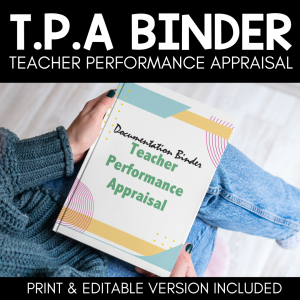Teaching Authentically: Navigating the TPA in Ontario
In the world of teaching, evaluations can be a nerve-wracking experience. This is especially true for the Teacher Performance Appraisal (TPA) in Ontario. Teachers often feel the pressure of ensuring they’re at their best, which can sometimes lead them to deviate from their authentic teaching selves and put on a “performance” during evaluations like the Ontario TPA.

But what if the TPA wasn’t about putting on a show? What if, instead, it became an opportunity to showcase our daily teaching practices?
Listen to the podcast
What is the Ontario TPA?
The TPA is a systematic process through which teachers are appraised on their teaching practices based on a set of criteria. In Ontario, the focus is on four core competencies that evaluate teachers on their understanding and implementation of effective teaching methodologies.
The Evolution of Teaching Methodologies
Not so long ago, many educators relied on traditional teaching methods, with rows of students completing worksheets or listening to long lectures. Then, the pandemic hit, forcing many to shift their teaching approaches. New teaching methodologies emerged with an increased emphasis on student engagement and holistic learning.
An Authentic Approach to the Ontario TPA
When I was approaching my TPA, I questioned why many of my peers felt the need to deviate from their regular teaching methods. Why the change? Isn’t every day supposed to be a reflection of our teaching abilities? My approach was to stay true to myself and my teaching methods. I wanted the TPA to be a reflection of my daily practices.
The Over-Reliance on Worksheets
While worksheets can be a beneficial tool, they shouldn’t be the primary resource. True learning goes beyond filling in the blanks. It’s about understanding concepts, engaging in discussions, and exploring new ideas. Relying heavily on worksheets can limit a student’s learning experience and hinder their overall development.
The Importance of Differentiation
Every student is unique. Hence, our teaching methods should accommodate these differences. By providing multiple entry points and differentiation, we can ensure that all students feel included, engaged, and challenged in their learning journey.
Modern vs. Outdated Teaching Methodologies
The teaching landscape is ever-evolving. With advancements in technology and pedagogy, the traditional ways of teaching are becoming obsolete. Instead, teachers are now focusing on inquiry-based methodologies, student-centric approaches, and collaborative learning environments.
Continuous Learning: The Spiraled Mathematics Program
During my TPA, I had the opportunity to implement a spiraled mathematics program. This approach emphasizes the significance of ongoing professional learning. As teachers, our learning should never stop. By continuously updating our skills and knowledge, we can offer our students the best learning experience possible.
Ontario TPA Conclusion
The Teacher Performance Appraisal shouldn’t be a dreaded event. Instead, let it be a reflection of our daily teaching practices. Let’s move away from outdated methods and embrace new pedagogies that truly benefit our students. Remember, true education is about authentic engagement, not just performances. Let’s make every day a TPA day!
Ontario TPA Resources:
- Ministry’s guidelines on teaching methodologies
- Universal design practices
- Current pedagogies on inquiry methodologies
Share this blog with fellow educators and let’s challenge ourselves to align our daily teaching practices with the core competencies of the TPA.






